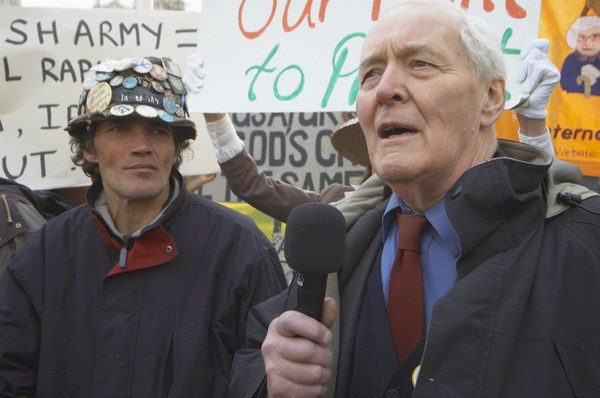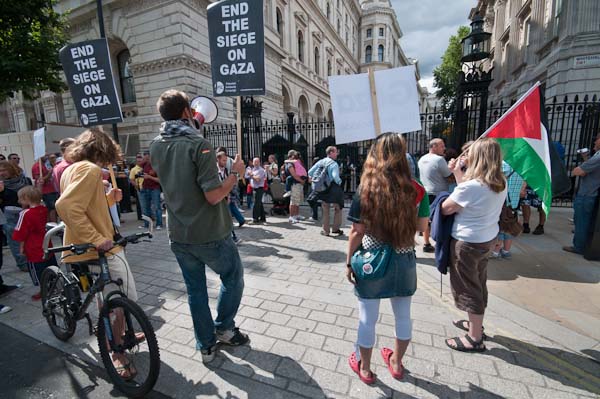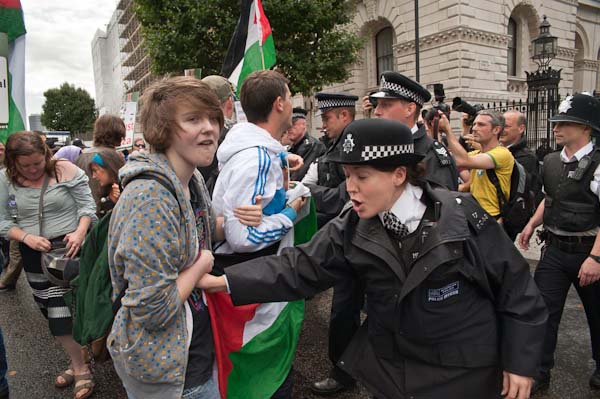Britain is still in many ways a free country, but some parts are less free than others. One of those parts is Whitehall and the whole area around the Houses of Parliament, where laws about protests were a last-minute addition to the Serious Organised Crimes and Police Bill when it was going before parliament – and passed as SOCPA.

Brian Haw and Tony Been at rally against SOCP Bill, March 2005
Blair and his mates were getting really fed up with Brian Haw’s presence on the grass opposite the Houses of Parliament with a large display reminding them what a mess they had made over Iraq. Caught out misleading the public with a dodgy dossier, and then the incredible mistakes made by our allies in dismantling the country, leading to years of bloodshed, chaos and overspend, with little prospect of a real end in sight.
Hardly surprising they didn’t want a noisy reminder in the neighbourhood, and a few attempts at getting their mates in the police and elsewhere to try a few underhand moves had failed. They couldn’t really come out in the open and draft a Brian Haw Removal Bill, so they tacked it on to what became SOCPA.
But for various reasons they didn’t get it quite right, and Brian Haw remained. Even a rather dodgy judgement in their favour didn’t quite sort the matter out, and he is still there, if in a somewhat reduced format, over 3000 days since his protest started.
SOCPA as it relates to demonstrations does seem more or less discredited now, and we were promised new legislation, but for the moment it’s still a stick the police can wave, if not much more.
One place that many want to demonstrate, other than the Houses of Parliament, is Downing St, the home and office of our Prime Minister, but of course this is no longer open to the public. As I mentioned in a piece about Philip Jones Griffiths, it isn’t so long since anyone could walk down it, and nannies would stop to chat up the police on duty outside its famous door. Now tourists need binoculars to see it through tall gates.
Protesters are not even allowed to stand on the same side of Whitehall as the tourists, but must make their protest from the far side of Whitehall, around 85 yards away from the door to No 10 (according to Google maps, though it actually looks further on the ground.)

Illegal protest at Downing St
SOCPA also led to a ban on the use of any megaphone or other electrical amplification, so people have to shout, often over the noise of the sometimes heavy traffic along a busy road with several lanes in each direction.
Those in No 10 can’t of course see the demonstrations either. Their windows either look out in completely the wrong direction or into the narrow street banned to the public in front – where all they can see is the press waiting in their pen to take photographs.
Occasionally some of the civil servants do come out into the road and walk down and stand near the fence so they can see and hear the protests, but I should imagine that otherwise those in the building remain totally unaware. While I don’t think that protests should be able to completely disrupt the business there, I think we need a balance where protests can be noticed, and that seems to no longer be the case.
On Tuesday, protesters against the talkes between Gordon Brown and Benjamin Netanyahu decided to cross the road and carry out an illegal protest on the pavement immediately in front of the gates. They moved obediently to one side for a couple of vehicles to come in and out of the gates; given the group of armed police hanging around behind them they obviously made no attempt to enter Downing St itself.
Also they decided to make illegal use a megaphone. After around 20 minutes the police decided to come and warn them that what they were doing was illegal and that they would be arrested if they continued. More protesters came across from the ‘legal’ side of the road and joined them. Police formed a loose line to clear a token few yards of pavement in front of the gates and the demonstration continued.

An hour later, reinforcements arrived and the demonstration organisers (who were not those who had decided to come across the road) were I think told that people would be moved by force if necessary. Someone from ‘Stop The War‘ made a short speech about the demonstration including a plea for people to move (again I think he was probably told by police he could use a megaphone to do so.) I think he was about the only person that took his advice, but police (we were told they were TSG but they were wearing normal police uniforms rather than their rioting kit) pushed the demonstrators back. Mostly this was done with reasonable force, though I did see (but was unable to photograph) one momentary loss of temper.
In the confusion while this was being done, three people who had been warned earlier were taken into custody. After I left, close to the scheduled end of the event, two further arrests were made.
Police appear to be making use of their powers to hold people as a kind of minor punishment system. The five were kept at Belgravia police station until some time after 11pm before being released. I was told that it’s unlikely they will be taken to court.
More about the protest and more pictures on My London Diary.